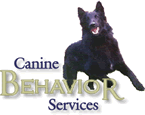Your Weekly Training Tip
May 2, 2010
When I am out training, demonstrating, or playing with my dogs, I often get asked the question "how in the world did you teach your dog that?", about some trick or command my dogs know. While I might enjoy giving some awe-inspiring response as to how I carefully shaped the behavior, using all my skills as a dog trainer, gleaned through countless hours of hard work and study over the last twenty years --- well, all too often, this is not the case. Truth is, I tend to be a least-effort trainer. While I love to train, I have other interests, too, not to mention a generally busy life! So, if there is an effortless (or nearly so) way of teaching a behavior, by golly, I'll take it. And one of the most effortless ways to teach a behavior (or, more accurately, put a behavior on cue) is to take advantage of the dog's admirable ability to make associations between events. We see examples of this daily when our dogs run to the door for a walk when we pick up a leash, or run to their crates or napping spots when we get read to leave in our work clothes. Dogs run to the kitchen at the sound of dog bowls clanking, and to the front door when they hear a vehicle in the driveway. Some dogs hide when they see nail clippers picked up. Were these behaviors "taught"? Not intentionally. Our dogs learned these responses by associating one event with another. "Events" can be just about anything: the sound of a delivery truck, the sight of the leash, a touch, a scent, and yes - a word. And yet, too often, I find that dog owners have no idea that they can use association as a training approach. You can greatly increase your dog's vocabulary, with almost no effort, by using association. Think of any behavior that your dog currently does on her own that would be cute, entertaining, or practical to have on cue. Then decide on a unique verbal cue, and say it as your dog performs that behavior. If the behavior is one that that passes quickly, you will probably have time to say your cue just once. If it's one that lasts any time, continue to repeat your cue for as long as she continues to perform the behavior. Do this at every available opportunity, until your dog associates the word or phrase with the action. It would be hard to find a training method much more simple than that! It requires no special skills or tools, not even treats. I love this method, and have taught my dogs many of their most useful day-in, day-out commands, as well as fun tricks, using this very approach.
Have fun with this - it's one of my favorite training techniques. I would love to hear what you teach using this method! Until next week, Happy Training!
Julie Cantrell BSc, CPDT-KA, CDBC |
Free Dog Training & Behavior Tips If you enjoy our training tips, sign up here to get them in your inbox! With each issue, you'll understand your dog better, and enjoy training more! |
www.k9behaviorservices.com

